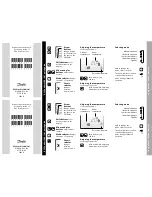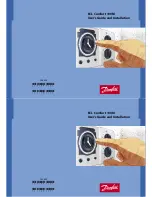
2-7
Level Controller Overview and Installation
BENCH CONFIGURATION
Before mounting the Level Controller in the field, the controller can be
configured on the bench using a Model 275 HART Communicator.
NOTE
For bench configuration, a jumper must be installed across the
output terminals.
Failure Mode Alarm vs.
Saturation Output Values
Failure mode alarm output levels differ from the output values that
occur when applied pressure is outside the range points. When pressure
is outside the range points, the analog output continues to track the
input pressure until reaching the saturation value listed below; the
output does not exceed the listed saturation value regardless of the
applied pressure. For example, for pressures outside the 4–20 range
points, the output saturates at 3.9 mA or 20.8 mA.
When the controller diagnostics detect a failure, the analog output is
set to a specific alarm value that differs from the saturation value to
allow for proper troubleshooting.
Write Protect and
Failure Mode
Alarm Jumpers
These jumpers are both located on the electronics board just inside the
electronics housing cover (see Figure 2-5). Set these jumpers during the
commissioning stage on the bench to avoid exposing the controller
electronics to the plant environment after installation.
Once the controller has been configured, the configuration data can be
protected by moving the write protect (security) jumper. When this
jumper is installed, the controller does not allow any changes to its
configuration memory.
In the event of a critical hardware failure in the controller, the
controller automatically drives the analog output either below 3.75 or
above 21.75, depending on the position of the failure alarm jumper.
NOTE
This alarm jumper is different from a level measurement alarm
condition. As part of its normal operation, the Level Controller
continuously monitors its own operation. This automatic diagnostic
routine is a timed series of checks repeated continuously.
If the controller determines that a level measurement alarm exists, the
controller performs one of the two Mode Shed routines (user selected):
– the controller signal freezes at the current level
– the signal switches to a pre-determined mode shed level
See Chapter 4 for additional mode shed information.
When shipped from the factory, the write protect jumper is set to
“OFF,” and the alarm jumper is set to “LO.”
Level
4–20 mA Saturation Value
4–20 mA Alarm Value
Low
3.9 mA
3.75 mA
High
20.8 mA
21.75 mA
Summary of Contents for 3095
Page 2: ......
Page 4: ......
Page 8: ...viii ...
Page 10: ...Rosemount Model 3095 Multivariable Level Controller 1 2 ...
Page 42: ...Rosemount Model 3095 Multivariable Level Controller 3 10 ...
Page 74: ...Rosemount Model 3095 Multivariable Level Controller 5 18 ...
Page 98: ...Rosemount Model 3095 Multivariable Level Controller B 4 ...
Page 101: ...C 3 Approval Drawings FIGURE 3 1 continued 3095 1025A02A ...
Page 102: ...Rosemount Model 3095 Multivariable Level Controller C 4 FIGURE 3 1 continued 3095 1025A03A ...
Page 103: ...C 5 Approval Drawings FIGURE 3 2 Index of I S F M for 3095 3095 1020A01A ...
Page 104: ...Rosemount Model 3095 Multivariable Level Controller C 6 FIGURE 3 2 continued 3095 1020A02A ...
Page 105: ...C 7 Approval Drawings FIGURE 3 2 continued 3095 1020A03A ...
Page 106: ...Rosemount Model 3095 Multivariable Level Controller C 8 FIGURE 3 2 continued 3095 1020A04A ...
Page 107: ...C 9 Approval Drawings FIGURE 3 2 continued 3095 1020A05A ...
Page 108: ...Rosemount Model 3095 Multivariable Level Controller C 10 FIGURE 3 2 continued 3095 1020A06A ...
Page 110: ...Rosemount Model 3095 Multivariable Level Controller C 12 FIGURE 3 3 continued 3095 1024A02A ...
Page 111: ...C 13 Approval Drawings FIGURE 3 3 continued 3095 1024A03A ...
Page 113: ...C 15 Approval Drawings FIGURE 3 4 continued 3095 1021A02A ...
Page 114: ...Rosemount Model 3095 Multivariable Level Controller C 16 FIGURE 3 4 continued 3095 1021A03A ...
















































